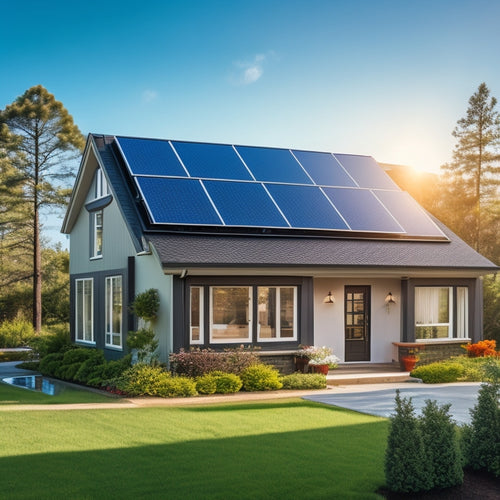
What's Causing the Increase in Solar Panel Installation Fees?
Share
You're not alone in noticing the surge in solar panel installation fees, which have jumped by as much as 20% in the past year. Several factors are contributing to this increase, including rising material costs due to high demand and scarcity, increased labor and overhead expenses stemming from labor shortages and higher operational costs, and advanced technology features like smart inverters and energy storage capabilities. Additionally, permit and inspection fees, supply chain and logistics challenges, and profit margins and competition all play a role. As you investigate your solar panel installation options, understanding these factors will help you make an informed decision about your investment.
Key Takeaways
- Rising material costs, driven by high demand and supply chain disruptions, contribute to increased solar panel installation fees.
- Labor shortages and investments in training programs lead to higher labor costs, which are reflected in installation quotes.
- Advanced technology features, such as smart inverters and energy storage capabilities, increase the cost of solar panel installations.
- Permit and inspection fees, including plan check fees and inspection costs, are rising due to regulatory changes and municipal charges.
- Supply chain and logistics challenges, including shipping delays and material procurement issues, drive up overall project costs.
Rising Material Costs Impact
As solar panel installation fees continue to rise, the impact of escalating material costs becomes increasingly apparent.
You're likely aware that solar panels rely heavily on renewable resources, such as silicon, aluminum, and glass. However, the increased demand for these materials has led to material scarcity, driving up costs.
The effects of material scarcity are far-reaching. You may have noticed that the cost of silicon, a vital component in solar panels, has skyrocketed in recent years. This is partly due to the surge in global demand for solar panels, outpacing the supply of silicon.
Additionally, the extraction and processing of these materials require significant energy and resources, adding to the overall cost.
As a result, you're likely seeing higher quotes for solar panel installations. While the benefits of renewable energy sources are undeniable, the rising material costs can't be ignored.
It's important to take these factors into account when evaluating the feasibility of solar panel installation for your home or business.
Increased Labor and Overhead
Rising material costs are just one piece of the puzzle driving up solar panel installation fees. As you explore further, you'll find that increased labor and overhead expenses are also playing a significant role.
Labor shortages in the solar industry have led to higher labor costs, making it more expensive for companies to hire and retain skilled workers. To combat this, many companies are investing in training programs to develop the skills of their existing workforce. However, these programs come at a cost, which is then passed on to you, the consumer.
As the demand for solar panels continues to grow, companies are struggling to keep up with the workload. This has led to increased overhead expenses, including higher marketing and sales costs, as companies compete for a limited pool of skilled laborers.
Additionally, companies are facing higher operational costs, such as rent and utilities, as they expand their operations to meet demand. These increased labor and overhead expenses are being factored into the overall cost of solar panel installation, making it more expensive for you to go green.
Advanced Technology and Features
With the increasing demand for solar panels, manufacturers have been driven to incorporate advanced technology and features into their products, further contributing to the rise in installation fees. You're likely to notice that modern solar panels now come equipped with smart inverters, which enable real-time monitoring and optimization of energy production. This advanced technology allows for more efficient energy harvesting and reduces the risk of energy loss.
| Feature | Description |
|---|---|
| Smart Inverters | Real-time monitoring and optimization of energy production |
| Energy Storage | Enables energy storage for later use, reducing grid dependence |
| Advanced Panel Materials | Improved efficiency and durability of solar panels |
| Integrated Monitoring Systems | Real-time monitoring of system performance and energy production |
| Grid-Tie Functionality | Enables seamless integration with the grid, reducing installation complexity |
These advanced features and technologies not only enhance the overall performance of your solar panel system but also increase the installation cost. As you consider investing in solar energy, it's crucial to weigh the benefits of these advanced features against the additional cost.
Permit and Inspection Fees
When you're installing solar panels, you'll need to factor in permit and inspection fees, which have been increasing due to rising municipal charges.
You'll also face higher plan check fees, as local authorities review your installation plans more thoroughly.
Additionally, you can expect an increased inspection frequency, which will further drive up costs.
Rising Municipal Charges
Across the country, municipal governments are increasing permit and inspection fees for solar panel installations, adding to the overall cost of going solar. You're not alone in wondering why these fees are rising. The truth is, regulatory changes and local policies are driving these increases. As you maneuver through the process of installing solar panels, it's critical to comprehend these changes and how they impact your wallet.
| Municipality | Old Permit Fee | New Permit Fee |
|---|---|---|
| City A | $500 | $750 |
| City B | $300 | $450 |
| City C | $200 | $350 |
| City D | $400 | $600 |
These increases may seem small, but they can add up quickly. You need to factor them into your overall budget to guarantee you're getting the best value for your investment. As you research local policies and regulations, you'll find that some municipalities are more solar-friendly than others. Understanding these differences can help you make informed decisions about your solar panel installation.
Higher Plan Check Fees
Plan check fees, a significant component of the overall permit and inspection process, are escalating in many municipalities. You're likely wondering what's driving this increase.
Several factors contribute to higher plan check fees. To begin with, design complexity plays a significant role. As solar panel systems become more sophisticated, the plans and drawings required for permitting become more intricate, resulting in longer review times and higher fees.
Additionally, regulatory changes at the local and state levels have led to more stringent review processes, further increasing plan check fees.
You may encounter the following costs:
- Municipalities are hiring more staff or consultants to handle the increased workload, resulting in higher fees.
- New software and technology are being implemented to streamline the plan review process, but this comes at a cost.
- Changes to building codes and ordinances require more detailed plans and drawings, leading to longer review times and higher fees.
Increased Inspection Frequency
You're about to face another significant cost driver in the solar panel installation process: increased inspection frequency. This surge in inspections translates to higher permit and inspection fees, adding to your overall project expenses.
The main culprits behind this trend are changing inspection standards and regulatory changes. As local governments and authorities work to guarantee solar panel installations meet safety and performance standards, they're introducing more stringent inspection protocols.
This means you'll need to undergo more frequent and thorough inspections, resulting in higher fees. For instance, some jurisdictions now require additional inspections for energy storage systems, which can increase the overall inspection frequency.
To comply with these new regulations, you may need to hire more inspectors or invest in specialized equipment, further driving up costs.
It's vital to factor these increased inspection fees into your project budget to avoid unexpected expenses. By understanding the reasons behind these changes, you can better maneuver through the solar panel installation process and make informed decisions about your project.
Supply Chain and Logistics
Several key players in the solar panel installation industry have reported significant disruptions to their supply chains in recent years, leading to increased costs and delays.
You're likely wondering how this affects your solar panel installation project. The truth is, supply chain issues can have a ripple effect on the entire process, from procurement to installation.
Some of the key challenges you may encounter include:
-
Shipping delays: With solar panels and components coming from overseas, any disruptions to global shipping can cause delays and increased costs.
-
Installation intricacy: As solar panel technology advances, installation becomes more intricate, requiring specialized tools and training, which can be in short supply.
-
Warehouse and inventory management: With more components to manage, warehouse space and inventory management become critical, and any inefficiencies can lead to increased costs.
These challenges can lead to increased installation fees as companies pass on the additional costs to consumers.
As you maneuver through the process of installing solar panels, it's crucial to comprehend the intricacies of the supply chain and how they can impact your project.
Profit Margins and Competition
As solar panel installation companies maneuver through the complexities of their supply chains, they must also contend with the pressures of a competitive market.
You're likely aware that market saturation has led to increased competition among installers, driving them to adopt various pricing strategies to stay ahead. This has resulted in a delicate balance between maintaining profit margins and offering competitive pricing to attract customers.
As you traverse the solar installation market, you'll notice that companies are walking a thin line between profitability and affordability.
To maintain their profit margins, some installers may increase their prices, while others may absorb the costs and sacrifice their margins to remain competitive. This fluid situation has led to a wide range of pricing options for customers, making it essential to research and compare prices before making a decision.
In this competitive environment, you must be aware of the pricing strategies employed by different installers.
Be cautious of companies that may be undercutting their competitors, as this could indicate a lack of quality or skill. Instead, look for installers that offer transparent pricing, quality products, and exceptional customer service.
Frequently Asked Questions
Can DIY Solar Panel Installation Save Me Money on Fees?
You can save money on fees by opting for DIY solar panel installation, but be prepared to tackle installation challenges; assessing DIY benefits against your technical knowledge and time commitment is essential to achieving cost savings.
How Do Seasonal Changes Affect Solar Panel Installation Costs?
As you steer through the solar panel installation process, you'll find that seasonal demand spikes like a surfer riding a wave, driving up costs when weather impacts, like harsh winters or scorching summers, make installations more complex and time-consuming.
Do Local Incentives Influence Solar Panel Installation Fees?
You'll find that local tax incentives and rebate programs considerably impact your solar panel installation fees, as they can offset costs or provide refunds, making sustainable energy more accessible and affordable for you and your community.
Can I Negotiate Solar Panel Installation Fees With Contractors?
As you step into the solar spotlight, you're wondering if you can negotiate installation fees with contractors. Yes, you can! Be prepared to discuss project details, and insist on fee transparency - a savvy approach that can help you shave dollars off the final bill.
Are Solar Panel Installation Fees Higher for Commercial Properties?
You'll find that solar panel installation fees are indeed higher for commercial properties due to unique commercial property considerations, such as larger system sizes and more complex installations, which drive up costs and influence installation fee trends.
Conclusion
As you consider going solar, it's crucial to understand the factors driving up installation fees. From rising material costs to increased labor and overhead, advanced technology, and permit fees, each component adds to the final bill. Notably, the cost of solar panels has dropped by 70% over the last decade, yet installation fees continue to rise. This paradox highlights the importance of understanding the breakdown of costs to make an informed decision about investing in solar energy.
Related Posts
-

Top 10 Tips for Buying Car Accessories Online
When purchasing car accessories online, you should take proactive steps to avoid low-quality or incompatible products...
-

Eco-Friendly Car Battery Solutions Available Online
You can now shop online for eco-friendly car battery solutions that not only reduce your carbon footprint but also of...
-

Solar Power Units Perfect for Homes
You're considering installing a solar power unit in your home, a decision that can notably reduce your reliance on tr...


